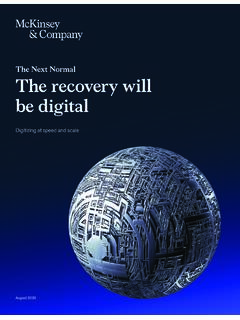Transcription of Infrastructure Investment & Jobs Act
1 Infrastructure Investment & Jobs Act August 2, 2021. The Senate this week is expected to pass the sweeping Infrastructure Investment & Jobs Act (IIJA). Nearly half of the $1 trillion measure would be allocated to federal highway, bridge and public transportation improvements. In addition to a $370 billion, five-year reauthorization of the surface transportation programs, the package includes $86 billion in supplemental resources for these programs. The remaining funds would be invested in other physical Infrastructure activities such as airports, rail, broadband, and energy. The text of the 2,700-page measure was released late August 1.
2 ARTBA's overview of the measure follows. Highways: $ Billion (35 percent of total). Core Programs: The measure's five-year reauthorization of highway and bridge programs through FY 2026 totals $ billion. It would be a 24 percent increase from the current year ($ billion) to the first year of the IIJA. ($ billion). State-by-state formula funding Funding by program Supplemental Investment : Negotiators bolstered the Senate's highway reauthorization plans with an additional $ billion ($ billion per year) to be distributed as follows: Additional Formula Programs ($ billion): $ billion distributed via a conditions-based formula for bridges ($ billion per year).
3 $5 billion distributed via existing program formula for EV Charging ($1 billion per year). Additional Discretionary Programs ($ billion): $ billion for the Nationally Significant Freight and Highway Projects Program $ billion for Bridge Discretionary Grant Program $500 million Reconnecting Communities Pilot Program $150 million for port emissions reduction Additional Programs ($ billion): $95 million additional for University Transportation Centers $ billion for Appalachian Development System $342 million for Ferry Boats and Ferry Terminal Projects Copyright 2021 ARTBA. As a result, total Investment for highway programs for FY 2022 FY 2026 would be $ billion.
4 The chart below shows the year-by-year funding levels proposed in the package compared to the last two years of core highway and appropriations spending an $ billion (38 percent) increase. Federal Highway Program Obligation Limitation Under FAST Act, IIJ Act, and Annual Appropriations Source: FHWA and Senate Infrastructure Investment and Jobs Act. Policy Highlights project Delivery & Process Improvement: Enacts into law former President Donald Trump's One Federal Decision Executive Order that sought to: o Consolidate all permitting decisions for major Infrastructure projects into one single environmental document with a schedule set by the federal lead agency; and o Finalize the environmental review process within an average time of two years and complete all authorization decisions for a major project within 90 days of the issuance of a record of decision.
5 Requires an annual report detailing progress made on improving project delivery, such as savings and identification of problem areas. Reduces the number of times states participating in the National Environmental Policy Act (NEPA). delegation program have to reapply. Decreases delays for projects already in an existing right of way and projects using limited federal funds by setting deadlines for permit approvals and increasing the use of categorical exclusions. Copyright 2021 ARTBA. Planning & Performance Management: Reforms the transportation planning process by eliminating the fiscal constraint requirements for projects beyond a four-year time frame.
6 Fiscal constraint requirements often complicate long-term planning because funding could not be predicted beyond the scope of the current reauthorization bill. Climate Change: Makes $ billion in funding available to develop charging stations for alternative fuel vehicles and to encourage electrification of port facilities and the reduction of truck idling. Focuses new and existing grant programs on making Infrastructure more resilient as well as congestion management. Establishes a carbon reduction program setting aside funds for projects aimed at reducing transportation related emissions.
7 States participating in this program will submit carbon reduction strategies to DOT. Transportation Infrastructure Finance and Innovation Act (TIFIA): Expands eligibility for the TIFIA program to certain transit-oriented and airport projects. Requires clearer timelines for the TIFIA application review and approval process, an expedited decision process for certain borrowers, and periodic on-line reports regarding application status. Private Activity Bonds (PABs): Raises the cap on PABs from $15 billion to $30 billion to support public-private partnerships. Buy America: Expands Buy America to construction materials, which must be produced in the United States.
8 Requires review of general waivers to the program. Exempts cement and cementitious materials, aggregates such as stone, sand, or gravel, or aggregate binding agents or additives from the definition of construction materials. Tightens Buy America flexibility formerly given to commercially available off-the-shelf products. Local Hire: Allows state or local agencies to implement local, geographical or economic hiring preferences. Instructs the Department of Transportation ( DOT) to provide Congress with a workforce diversity report relating to pre-apprenticeship programs, barriers to employment and other topics.
9 Directs DOT to formulate a model plan for agencies to address employment diversity issues. Workforce: Instructs the DOT to conduct research related to workforce needs and allocates $25 million for a public service announcement campaign. Copyright 2021 ARTBA. Safety: Provides the opportunity for safety contingency funds that can be used to improve safety in work zones prior to, or during, construction. Institutes numerous policy changes throughout the bill to protect vulnerable road users,' like pedestrians, bicyclists and people with disabilities. Requires updates to the Manual on Uniform Traffic Control Devices (MUTCD) every four years.
10 Expands the focus of the MUTCD to include areas such as vulnerable road users' and automated vehicles Public Transportation: $ Billion ( percent of total). Core Programs: Public transit formula supported funding would grow from $ billion in FY 2021 to $ billion in FY. 2022 a 31 percent increase. These resources can be invested in multiple areas, including bus grants and capital and station improvements. The five-year total Investment for these programs is $ billion. The Capital Investment Grant (CIG) Program would receive $15 billion over five years ($3 billion per year). to support light-rail and other capital-intensive transit projects.




